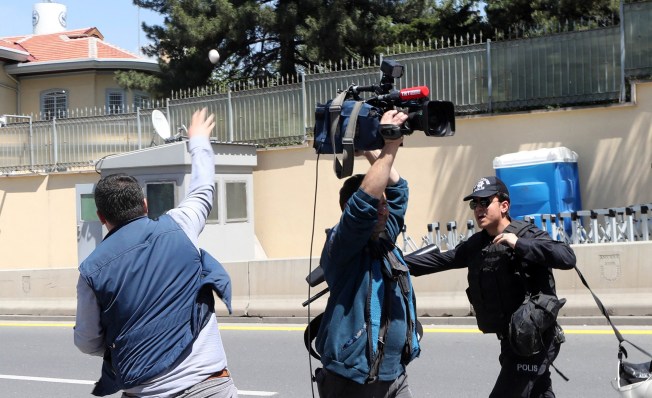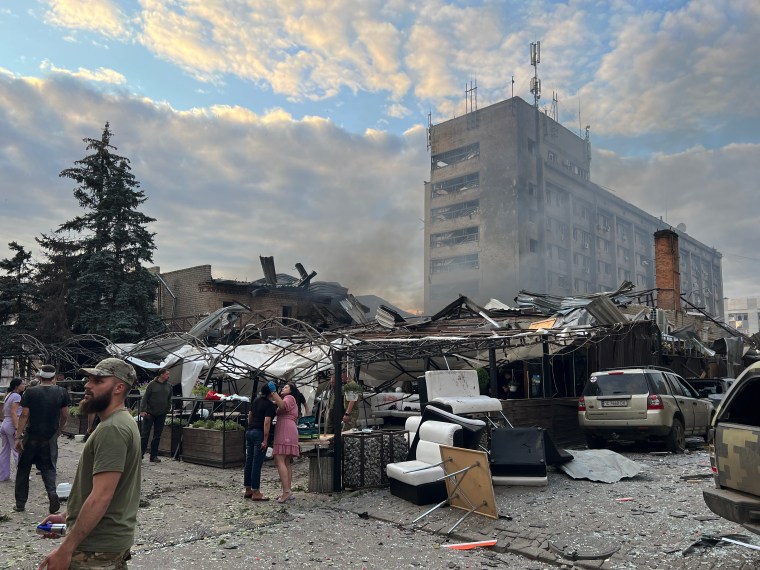The Torch is a weekly newsletter from the Committee to Protect Journalists that brings you the latest press freedom and journalist safety news from around the world. Subscribe here.
British photojournalist Anastasia Taylor-Lind and her Ukrainian producer Dmytro were planning their next day of reporting over dinner in Kramatorsk when a Russian missile crashed into the restaurant.
The two journalists were among dozens injured; 13 were killed. The June 27 bombing of the Ria Lounge, a popular hangout for local journalists, was a stark reminder of the risks journalists face to bring the world news of the conflict, risks that are hardly diminished when journalists are off duty.
“Everything happened in a split second,” Taylor-Lind told CPJ’s Anna Brakha in an interview after the attack. “While my eyes were closed, I heard a dull thud of the impact, and then I heard the sound of everything shattering and flying.”
Taylor-Lind said her experience was not unusual for journalists covering Ukraine. “The fact is, we are just two of many media workers injured in Ukraine by Russian attacks in the course of our reporting work.”
Read the full feature article about the bombing here.
💡 Read more of CPJ’s coverage of Ukraine
📣 Share our safety advice for war reporting
Global press freedom updates
- Russia’s Supreme Court upholds 22-year prison sentence for journalist Ivan Safronov
- Zimbabwean reporter Columbus Mavhunga faces jail over drone reporting
- At least seven Ugandan journalists assaulted, robbed at news conferences
- Haitian broadcaster Radio Antarctique burned down in gang attack
- Azerbaijani journalist Vugar Mammadov sentenced to 30 days in jail over interview
- Journalists Andersson Boscán and Mónica Velásquez flee Ecuador amid threats
- Sri Lankan police arrest, beat journalist Tharindu Uduwaragedara
- Salvadoran journalist Victor Barahona detained overnight
- Russian authorities in Crimea detain two journalists; Kulamet Ibraimov remains in custody

When talking about journalist safety, security measures such as filling out a risk assessment, completing hostile environment awareness training (HEFAT), or using personal protective equipment (PPE) are often the first things to come to mind.
However, one of the most important security measures in a journalist’s toolbox is the ability to maintain awareness of your surroundings and to remove yourself from harm’s way in advance of a threat.
CPJ’s Emergencies team created a guide about situational awareness to help journalists and editors plan assignments, whether they are reporting during extreme weather, in hostile environments, or in other situations that could potentially escalate.
📝 Basic preparedness: Risk assessment
💡 CPJ’s journalist security guide
🎥 How to safely cover protests
⚡️ Physical safety: Solo reporting
📣 Scroll through all of CPJ’s safety and emergency resources
Journalists requiring assistance can contact CPJ via emergencies@cpj.org
What we are reading
- Just call them hostages —Daniel Sharp and Jason Rezaian, Center for Strategic and International Studies
- Journalism in Turkey: I don’t feel safe — Elif Akgül and Laura Kunzendorf, Media and Law Studies Association
- Press freedom on trial in Guatemala — Christophe Deloire and José C. Zamora, Project Syndicate
- A mere SLAPP on the wrist: Is Europe’s commitment to uphold media freedom a false promise? — Emma Bergmans and Corinne Vella, Euronews
- ‘Journalists can serve democracy but they can’t save it’: Joel Simon — Abhinav Chakraborty, Frontline
- Abraham Jiménez Enoa: ‘In Cuba it’s almost impossible to express an opinion’ — Benjamin von Wyl, Swissinfo
Do you have an Amazon Alexa-enabled device? Enable CPJ's flash briefing skill to stay up to date with the latest press freedom news from around the world.
